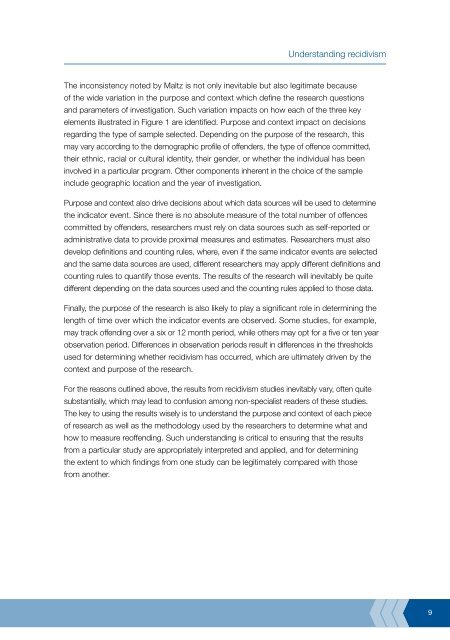Recidivism in Australia : findings and future research - Australian ...
Recidivism in Australia : findings and future research - Australian ...
Recidivism in Australia : findings and future research - Australian ...
Create successful ePaper yourself
Turn your PDF publications into a flip-book with our unique Google optimized e-Paper software.
Underst<strong>and</strong><strong>in</strong>g recidivism<br />
The <strong>in</strong>consistency noted by Maltz is not only <strong>in</strong>evitable but also legitimate because<br />
of the wide variation <strong>in</strong> the purpose <strong>and</strong> context which def<strong>in</strong>e the <strong>research</strong> questions<br />
<strong>and</strong> parameters of <strong>in</strong>vestigation. Such variation impacts on how each of the three key<br />
elements illustrated <strong>in</strong> Figure 1 are identified. Purpose <strong>and</strong> context impact on decisions<br />
regard<strong>in</strong>g the type of sample selected. Depend<strong>in</strong>g on the purpose of the <strong>research</strong>, this<br />
may vary accord<strong>in</strong>g to the demographic profile of offenders, the type of offence committed,<br />
their ethnic, racial or cultural identity, their gender, or whether the <strong>in</strong>dividual has been<br />
<strong>in</strong>volved <strong>in</strong> a particular program. Other components <strong>in</strong>herent <strong>in</strong> the choice of the sample<br />
<strong>in</strong>clude geographic location <strong>and</strong> the year of <strong>in</strong>vestigation.<br />
Purpose <strong>and</strong> context also drive decisions about which data sources will be used to determ<strong>in</strong>e<br />
the <strong>in</strong>dicator event. S<strong>in</strong>ce there is no absolute measure of the total number of offences<br />
committed by offenders, <strong>research</strong>ers must rely on data sources such as self-reported or<br />
adm<strong>in</strong>istrative data to provide proximal measures <strong>and</strong> estimates. Researchers must also<br />
develop def<strong>in</strong>itions <strong>and</strong> count<strong>in</strong>g rules, where, even if the same <strong>in</strong>dicator events are selected<br />
<strong>and</strong> the same data sources are used, different <strong>research</strong>ers may apply different def<strong>in</strong>itions <strong>and</strong><br />
count<strong>in</strong>g rules to quantify those events. The results of the <strong>research</strong> will <strong>in</strong>evitably be quite<br />
different depend<strong>in</strong>g on the data sources used <strong>and</strong> the count<strong>in</strong>g rules applied to those data.<br />
F<strong>in</strong>ally, the purpose of the <strong>research</strong> is also likely to play a significant role <strong>in</strong> determ<strong>in</strong><strong>in</strong>g the<br />
length of time over which the <strong>in</strong>dicator events are observed. Some studies, for example,<br />
may track offend<strong>in</strong>g over a six or 12 month period, while others may opt for a five or ten year<br />
observation period. Differences <strong>in</strong> observation periods result <strong>in</strong> differences <strong>in</strong> the thresholds<br />
used for determ<strong>in</strong><strong>in</strong>g whether recidivism has occurred, which are ultimately driven by the<br />
context <strong>and</strong> purpose of the <strong>research</strong>.<br />
For the reasons outl<strong>in</strong>ed above, the results from recidivism studies <strong>in</strong>evitably vary, often quite<br />
substantially, which may lead to confusion among non-specialist readers of these studies.<br />
The key to us<strong>in</strong>g the results wisely is to underst<strong>and</strong> the purpose <strong>and</strong> context of each piece<br />
of <strong>research</strong> as well as the methodology used by the <strong>research</strong>ers to determ<strong>in</strong>e what <strong>and</strong><br />
how to measure reoffend<strong>in</strong>g. Such underst<strong>and</strong><strong>in</strong>g is critical to ensur<strong>in</strong>g that the results<br />
from a particular study are appropriately <strong>in</strong>terpreted <strong>and</strong> applied, <strong>and</strong> for determ<strong>in</strong><strong>in</strong>g<br />
the extent to which f<strong>in</strong>d<strong>in</strong>gs from one study can be legitimately compared with those<br />
from another.<br />
9















